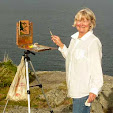Demo - Jackson Dinghy
8"x8" on 3/4" gallery wrap canvas
8"x8" on 3/4" gallery wrap canvas
On Saturday I did a demo at the For the Love of Art event at the Drawing Room at Anthi Frangiadis Associates in Marion, MA. It was a lot of fun, with engaged viewers who asked very good questions. It had been a couple of years since I'd done a full painting demo, but lots of hours teaching with minim demos had happened in between. Luckily I also remembered something I'd learned in my previous career, after not doing very well on panel discussion that I tried to do off the top of my head: preparation is key! Here's my advice and what I did to prepare:
- Choose subject your audience can appreciate. I prefer to do demos from life, but that has to be balanced with what your audience would like to see. In this boating community, I knew what my subject needed to be, even though it was the dead of winter!
- Choose a painting that you've painted before.
- Practice the drawing several times over a couple of days. A solid drawing makes for a stress free demo. My goal was to draw from the photo and then to add a grid and compare my drawing on the canvas with a photo that also had the grid as a way for the viewers to check my accuracy. So I practiced drawing on paper from the plain photo and then adding the gird and fixing my mistakes. It was instructive!
- Practice the demo painting, i.e., paint the whole thing. This was important because it had been a couple of years since I'd painted the original. I had to remember how to mix all the colors so as to not waste time experimenting during the demo. And I found that my current process (with a value under painting and two layers of color) took more than 2 hours, so I shortened it to one layer of color for the demo.
- I didn't practice what I was going to say. I could talk all day long about the painting process!
Interestingly, even with the explanations and answering questions, the demo was less than an hour and a half, so all was well. And I enjoyed it! That's good because I've got another one scheduled for an event in Boothbay Harbor, Maine, in June.








